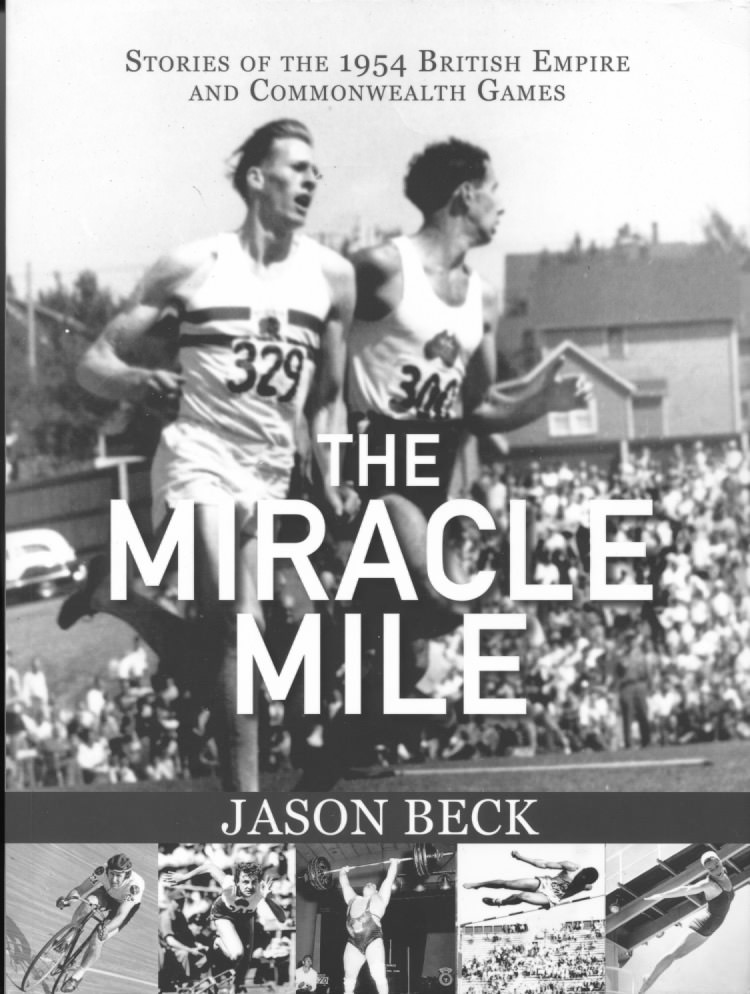Book Reviews
The Miracle Mile: Stories of the 1954 British Empire and Commonwealth Games
By John Cobley
10th July 2016
Book Review: The Miracle Mile: Stories of the 1954 British Empire and Commonwealth Games, by Jason Beck. Half Moon Bay, BC, Canada: Caitlin Press, 2016. Softback, $29. 95. 318pp
 |
This large-format book is beautifully produced (kudos to Vici Johnstone, who designed the over and text), and it offers a generous amount of black-and-white photography. It is clearly a labour of love for author Jason Beck, who is the Curator and Facility Director of the British Columbia Sports Hall of Fame in Vancouver. Much of the work on his ten-year project for this book was done while commuting. Although he had no spare time during business hours to work on this book, his job did give him one big advantage: “Access to the largest collection of BECG-related material anywhere in the world as well as key contacts, each of whom had some connection to the Games as an athlete, spectator, volunteer official or coach.” (BECG = British Empire and Commonwealth Games)
Beck’s research is impressive. He includes a mass of detail in his clear and readable text. For example, he tells us that the tape that Roger Bannister breasted ahead of John Landy in the Mile event was “two-ply baby wool finish-line string” and that the race was timed by 25 Omega stopwatches, each valued at $500 ($4,400 today). Apart from researching a vast amount of print material, Beck interviewed 75 people, including Roger Bannister, John Landy, Chris Chataway and Murray Halberg. The material from these interviews enriches this book immensely.
The structure of The Miracle Mile is based on the eight days of the Games. After two chapters of introduction, there is a chapter for each day of the Games. The first two chapters give a rich background on the preparation for the Games and introduce the three main athletes covered throughout the book: Bannister, Landy and Jim Peters. These two chapters are full of interesting material and rare photos, one of which depicts the “sod-turning ceremony” complete with a small-scale model of the stadium and with two very different models in one-piece bathing suits. The eight chapters that follow focus on the highlights of each day, whether it be athletics swimming, boxing, wrestling, weightlifting, rowing, fencing, diving or cycling. Although the two events of his featured three athletes were held of the last day of the Games, each of the eight chapters contains build-up material on the Mile and Marathon. For example, the separate arrivals of Landy and Bannister in Vancouver are covered. Their pre-race training sessions are described, as are their ways of relaxing. Likewise, Jim Peters’ training on the marathon course is fully covered. Completing the book, Beck provides a long informative chapter on the aftermath of the Games. This valuable chapter contains material on what happened to many of the Games’ heroes and heroines.
Although the book is tidily divided into the eight days of the Games, it’s hard to escape the feeling that there are really two books here: one on the various sports of the Games and one on the Mile and Marathon events. The main title of the book complicates matters even further: “The Miracle Mile” has no relevance to more than half of the book. That said, I would still say that the book will be of interest to readers of Racing Past. Although these readers may be disappointed that there is nothing on the 880, only two paragraphs on the Six Miles and just two pages on the Three Miles, the material on Bannister, Peters and Landy, as well as all the relevant photos, is definitely worth the price of the book.
Jason Beck has unearthed a lot of new material on both the background to the Mile and Marathon. This material, combined with information and comments from his interviews, enables Beck to provide the fullest and best commentaries in print on two of the most celebrated races in athletics history. Having written on both these races, I am in a good position to judge Beck’s work. It is superb.
But forgive me for making two small comments on his coverage of the Mile. First, I think Bannister’s 59.3 third lap needed comment. This was exceptionally fast for a third lap in a Mile. It says a lot for Bannister that he was still able to produce a devastating kick at the end of the race. Second, Beck gives the impression that all was matey-matey between the Mile competitors; however, I found that there was animosity towards the university-educated Bannister (and his colleagues Brasher and Chataway). Halberg wrote in his autobiography A Clean Pair of Heels that he found them “a little bit too aloof from the other competitors,” whereas they found Landy “a complete gentleman” and willing to spend time with his competitors. Because of this, Halberg, together with Bill Baillie and Victor Milligan “agreed that if we could be of any help to [Landy] at all during the race we would be.” Halberg may well have misread Bannister’s aloofness, but some animosity did exist at the Games.
Recommended with the caveat that the majority of this book covers the non-track-and-field sports of the 1954 British Empire and Commonwealth Games.
Leave a Comment